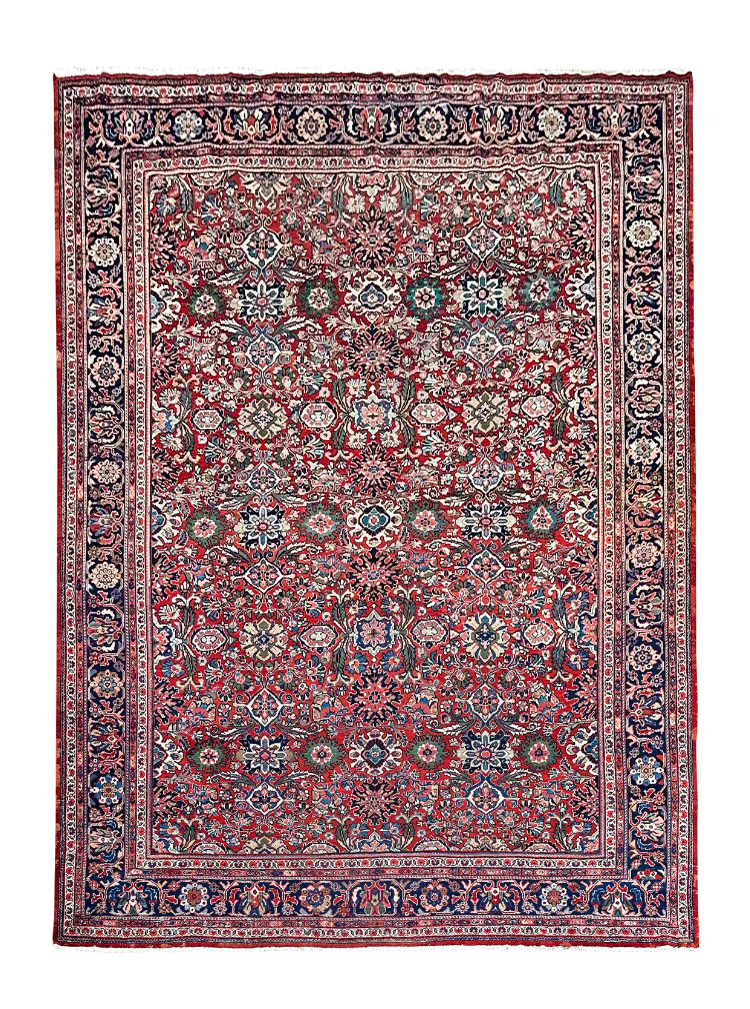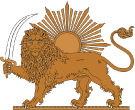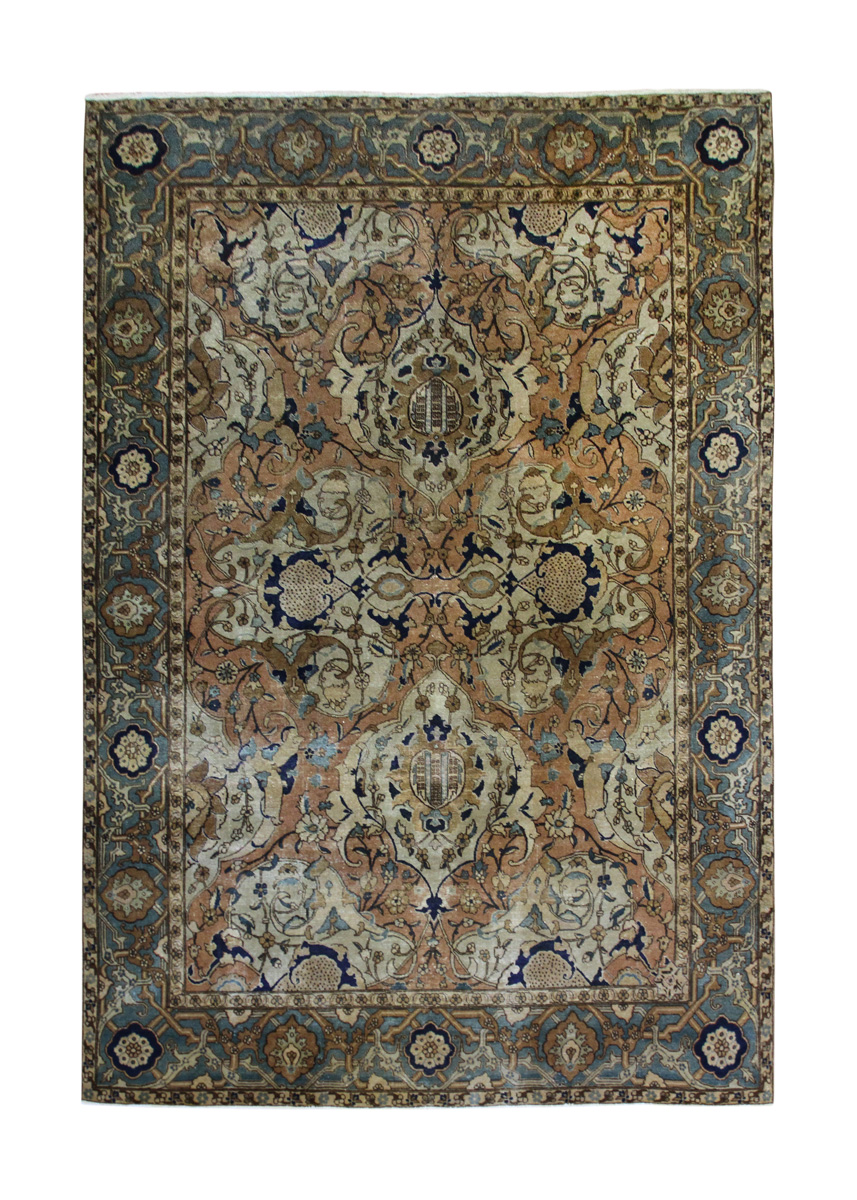-
 Kis Ghiordes, Turkey. 1920's Ghiordes (modern-day Gördes), a town 180 km from Smyrna, was a major carpet production center during the Ottoman Empire and gave its name to the Turkish or symmetrical knot known as the Ghiordes knot. The Kis Ghiordes carpet presented here, dating to the late 19th century and in excellent condition, measures 2.20 x 1.34 meters with a knot density of around 120,000 knots per square meter, using 100% wool for the pile, weft, and warp. These “Kis-Ghiordes” or “bride’s carpets” were traditionally woven by young girls as part of their dowry before marriage.
Kis Ghiordes, Turkey. 1920's Ghiordes (modern-day Gördes), a town 180 km from Smyrna, was a major carpet production center during the Ottoman Empire and gave its name to the Turkish or symmetrical knot known as the Ghiordes knot. The Kis Ghiordes carpet presented here, dating to the late 19th century and in excellent condition, measures 2.20 x 1.34 meters with a knot density of around 120,000 knots per square meter, using 100% wool for the pile, weft, and warp. These “Kis-Ghiordes” or “bride’s carpets” were traditionally woven by young girls as part of their dowry before marriage. -
 Rare Fine Silk Heriz, Iran 1850's This exquisite antique Persian Heriz silk rug, dating to around 1850, is a superb example of the master craftsmanship for which Heriz became famous. Woven entirely from silk, its rich luster, vivid colors, and sharp, detailed motifs showcase a remarkably high knot count and skillful artistry. The fine pile is cut close to highlight the crisp design, and the balanced field layout demonstrates the weaver’s exceptional precision. Silk’s unique sheen and softness add to its allure, making this rug not only visually stunning but also luxurious to touch. A true masterpiece, it is a prized find for serious collectors.
Rare Fine Silk Heriz, Iran 1850's This exquisite antique Persian Heriz silk rug, dating to around 1850, is a superb example of the master craftsmanship for which Heriz became famous. Woven entirely from silk, its rich luster, vivid colors, and sharp, detailed motifs showcase a remarkably high knot count and skillful artistry. The fine pile is cut close to highlight the crisp design, and the balanced field layout demonstrates the weaver’s exceptional precision. Silk’s unique sheen and softness add to its allure, making this rug not only visually stunning but also luxurious to touch. A true masterpiece, it is a prized find for serious collectors. -
 Harvey Nichol, Chinese. 1960's This is an extraordinary and unique antique Art Deco rug, renowned for its exceptional quality and unusually rare colour palette. It features remarkable design elements, showcasing an eye-catching combination of botanical and floral motifs. Rugs of this caliber are highly sought after and seldom found.
Harvey Nichol, Chinese. 1960's This is an extraordinary and unique antique Art Deco rug, renowned for its exceptional quality and unusually rare colour palette. It features remarkable design elements, showcasing an eye-catching combination of botanical and floral motifs. Rugs of this caliber are highly sought after and seldom found. -
 Turkish Panderna, early 1900's This rare and collectible Panderma Prayer Rug is a stunning example of antique Anatolian craftsmanship. Woven in the late 19th century in western Anatolia, Turkey, it features vibrant, naturally saturated vegetable dyes. The rug showcases traditional design motifs characteristic of the Balikesir region, making it a beautiful and authentic piece of Turkish heritage and wall décor.
Turkish Panderna, early 1900's This rare and collectible Panderma Prayer Rug is a stunning example of antique Anatolian craftsmanship. Woven in the late 19th century in western Anatolia, Turkey, it features vibrant, naturally saturated vegetable dyes. The rug showcases traditional design motifs characteristic of the Balikesir region, making it a beautiful and authentic piece of Turkish heritage and wall décor. -
 Mahal. Mahal Persian carpets from the late 19th and early 20th centuries are highly sought after by both connoisseurs and interior designers. Renowned for their folk art weaving and decorative aesthetic, these rugs are rare on the international market. They feature unique variations of classic Persian patterns like Herati, Mina Khani, and Harshang, often in soft pastels and earth tones. Produced as part of a cottage industry near the village of Mahal, these carpets have a looser weave and thicker pile, similar to nomadic rugs. Today, Mahal carpets stand alongside prestigious styles like Ferahan and Mahajiran Sarouk from the Arak region.
Mahal. Mahal Persian carpets from the late 19th and early 20th centuries are highly sought after by both connoisseurs and interior designers. Renowned for their folk art weaving and decorative aesthetic, these rugs are rare on the international market. They feature unique variations of classic Persian patterns like Herati, Mina Khani, and Harshang, often in soft pastels and earth tones. Produced as part of a cottage industry near the village of Mahal, these carpets have a looser weave and thicker pile, similar to nomadic rugs. Today, Mahal carpets stand alongside prestigious styles like Ferahan and Mahajiran Sarouk from the Arak region. -
 Kuba, South Caucasus, Russia. Early 1900's This exquisite 18th-century antique rug hails from the Kuba region of the Caucasus, renowned for its masterful weaving and intricate artistry. Known for finely woven, detailed designs often on a smaller scale, Kuba rugs are prized by collectors. This piece showcases a rich blend of cultural symbolism and artistic skill. Its central field features interconnected floral and geometric motifs in indigo, rust red, gold, and ivory, all softened by time and natural dyes. The floral designs symbolize fertility and prosperity, while the geometric shapes reflect harmony and balance, capturing the spiritual and natural heritage of the weavers.
Kuba, South Caucasus, Russia. Early 1900's This exquisite 18th-century antique rug hails from the Kuba region of the Caucasus, renowned for its masterful weaving and intricate artistry. Known for finely woven, detailed designs often on a smaller scale, Kuba rugs are prized by collectors. This piece showcases a rich blend of cultural symbolism and artistic skill. Its central field features interconnected floral and geometric motifs in indigo, rust red, gold, and ivory, all softened by time and natural dyes. The floral designs symbolize fertility and prosperity, while the geometric shapes reflect harmony and balance, capturing the spiritual and natural heritage of the weavers. -
 Kounakat Kuba, South Caucasus, Russia. Early 1900's This antique Kounakat Kuba carpet, dating from circa 1910, is a striking example of Caucasian weaving artistry. Featuring a rich palette of dark blue, light blue, and cream, the rug displays intricate geometric patterns typical of Kuba designs. The harmonious blend of deep and soft blues contrasts beautifully with the cream accents, highlighting the detailed motifs and craftsmanship. Woven with precision, this piece reflects the cultural heritage and traditional techniques of the region. Its timeless design and natural dyes have aged gracefully, making it a highly desirable collector’s item and a stunning addition to any space.
Kounakat Kuba, South Caucasus, Russia. Early 1900's This antique Kounakat Kuba carpet, dating from circa 1910, is a striking example of Caucasian weaving artistry. Featuring a rich palette of dark blue, light blue, and cream, the rug displays intricate geometric patterns typical of Kuba designs. The harmonious blend of deep and soft blues contrasts beautifully with the cream accents, highlighting the detailed motifs and craftsmanship. Woven with precision, this piece reflects the cultural heritage and traditional techniques of the region. Its timeless design and natural dyes have aged gracefully, making it a highly desirable collector’s item and a stunning addition to any space. -
 Quaskai Woolen, Iran. 1920’s This beautiful antique Persian Quaskai rug, dating from circa 1920, showcases the exceptional weaving skills of the nomadic Quaskai tribe of southern Persia. Known for their strong community spirit, Quaskai women collaborate in weaving and gathering natural dyes, reflecting their deep connection to each other and the environment. The rug features vibrant colors and tribal designs inspired by nature, with rows of abstract geometric floral patterns contrasted by refined, interconnected flowers in the border. Influences from Central Asia and the Caucasus are evident, making this rug a stunning example of Quaskai artistry and tradition.
Quaskai Woolen, Iran. 1920’s This beautiful antique Persian Quaskai rug, dating from circa 1920, showcases the exceptional weaving skills of the nomadic Quaskai tribe of southern Persia. Known for their strong community spirit, Quaskai women collaborate in weaving and gathering natural dyes, reflecting their deep connection to each other and the environment. The rug features vibrant colors and tribal designs inspired by nature, with rows of abstract geometric floral patterns contrasted by refined, interconnected flowers in the border. Influences from Central Asia and the Caucasus are evident, making this rug a stunning example of Quaskai artistry and tradition. -
 Kerman, Iran. 1960's This exquisite Kerman Persian rug, woven in 1960, features a stunning pink background that beautifully highlights its intricate design. Renowned for exceptional craftsmanship, Kerman rugs showcase delicate floral motifs and elegant medallions, expertly hand-knotted with fine wool and silk threads. The soft pink base adds a unique charm and warmth, contrasting gracefully with detailed patterns in blues, creams, and golds. This vintage rug reflects both artistic tradition and timeless elegance, making it a prized addition to any collection or interior. Its vibrant yet harmonious color palette and meticulous weaving embody the rich heritage of Persian rug artistry.
Kerman, Iran. 1960's This exquisite Kerman Persian rug, woven in 1960, features a stunning pink background that beautifully highlights its intricate design. Renowned for exceptional craftsmanship, Kerman rugs showcase delicate floral motifs and elegant medallions, expertly hand-knotted with fine wool and silk threads. The soft pink base adds a unique charm and warmth, contrasting gracefully with detailed patterns in blues, creams, and golds. This vintage rug reflects both artistic tradition and timeless elegance, making it a prized addition to any collection or interior. Its vibrant yet harmonious color palette and meticulous weaving embody the rich heritage of Persian rug artistry. -
 Gol Farhang, Bedjar, Iran. 1930's The Gol Farang Bedjar is a stunning antique rug woven in 1930, showcasing exquisite craftsmanship from its era. This rare piece features intricate patterns and rich, harmonious colors that reflect traditional weaving techniques. Its detailed motifs and durable wool construction highlight the artisan’s skill and cultural heritage. Perfectly aged with a soft patina, the rug adds timeless elegance and historical charm to any space. Ideal for collectors and enthusiasts, the Gol Farang Bedjar represents a valuable example of early 20th-century textile art, blending beauty, history, and functionality into a single masterpiece
Gol Farhang, Bedjar, Iran. 1930's The Gol Farang Bedjar is a stunning antique rug woven in 1930, showcasing exquisite craftsmanship from its era. This rare piece features intricate patterns and rich, harmonious colors that reflect traditional weaving techniques. Its detailed motifs and durable wool construction highlight the artisan’s skill and cultural heritage. Perfectly aged with a soft patina, the rug adds timeless elegance and historical charm to any space. Ideal for collectors and enthusiasts, the Gol Farang Bedjar represents a valuable example of early 20th-century textile art, blending beauty, history, and functionality into a single masterpiece -
 Fine Agra, India. Early 1900's This vintage Agra rug beautifully exemplifies traditional Indian weaving craftsmanship. It showcases detailed floral and geometric designs, bordered elegantly to highlight its intricate artistry. The soft cream, beige, blue, and subtle brick tones create a calm and timeless ambiance. Woven from wool, the rug combines durability with a textured feel, balancing practicality and elegance. Its classic patterns and gentle colors bring a refined touch to any room. Perfect for adding cultural depth and sophistication, this rug is a stunning piece that enhances both the style and atmosphere of any space.
Fine Agra, India. Early 1900's This vintage Agra rug beautifully exemplifies traditional Indian weaving craftsmanship. It showcases detailed floral and geometric designs, bordered elegantly to highlight its intricate artistry. The soft cream, beige, blue, and subtle brick tones create a calm and timeless ambiance. Woven from wool, the rug combines durability with a textured feel, balancing practicality and elegance. Its classic patterns and gentle colors bring a refined touch to any room. Perfect for adding cultural depth and sophistication, this rug is a stunning piece that enhances both the style and atmosphere of any space. -
 Sarap, Iran. 1900's Sarap rugs originate from the town of Sarab, located in the Azerbaijani province of northwestern Persia. These rugs are particularly distinctive due to their unique long and narrow format, often crafted as runners. The elongated design makes them ideal for hallways and narrow spaces, adding elegance and warmth to interiors. Sarab rugs are known not only for their shape but also for their traditional craftsmanship, rich patterns, and durable weaving techniques. They reflect the cultural heritage of the region, combining both practical use and artistic expression in a way that makes them highly sought after by collectors and interior designers alike
Sarap, Iran. 1900's Sarap rugs originate from the town of Sarab, located in the Azerbaijani province of northwestern Persia. These rugs are particularly distinctive due to their unique long and narrow format, often crafted as runners. The elongated design makes them ideal for hallways and narrow spaces, adding elegance and warmth to interiors. Sarab rugs are known not only for their shape but also for their traditional craftsmanship, rich patterns, and durable weaving techniques. They reflect the cultural heritage of the region, combining both practical use and artistic expression in a way that makes them highly sought after by collectors and interior designers alike -
 Khotan. Khotan rugs showcase a unique blend of Chinese and Persian design influences, combining motifs like Chinese fretwork and cloud bands with traditional Persian medallions and borders. They feature a soft, muted color palette dominated by earthy tones such as beige, ivory, soft reds, and blues, distinguishing them from more vibrant rugs. Handwoven from high-quality wool and sometimes silk, Khotan rugs are both durable and luxurious. Their designs balance floral motifs with geometric patterns like lattice and repeating medallions. Notably, many Khotan rugs have minimal or no pronounced borders, emphasizing simplicity and elegance
Khotan. Khotan rugs showcase a unique blend of Chinese and Persian design influences, combining motifs like Chinese fretwork and cloud bands with traditional Persian medallions and borders. They feature a soft, muted color palette dominated by earthy tones such as beige, ivory, soft reds, and blues, distinguishing them from more vibrant rugs. Handwoven from high-quality wool and sometimes silk, Khotan rugs are both durable and luxurious. Their designs balance floral motifs with geometric patterns like lattice and repeating medallions. Notably, many Khotan rugs have minimal or no pronounced borders, emphasizing simplicity and elegance





